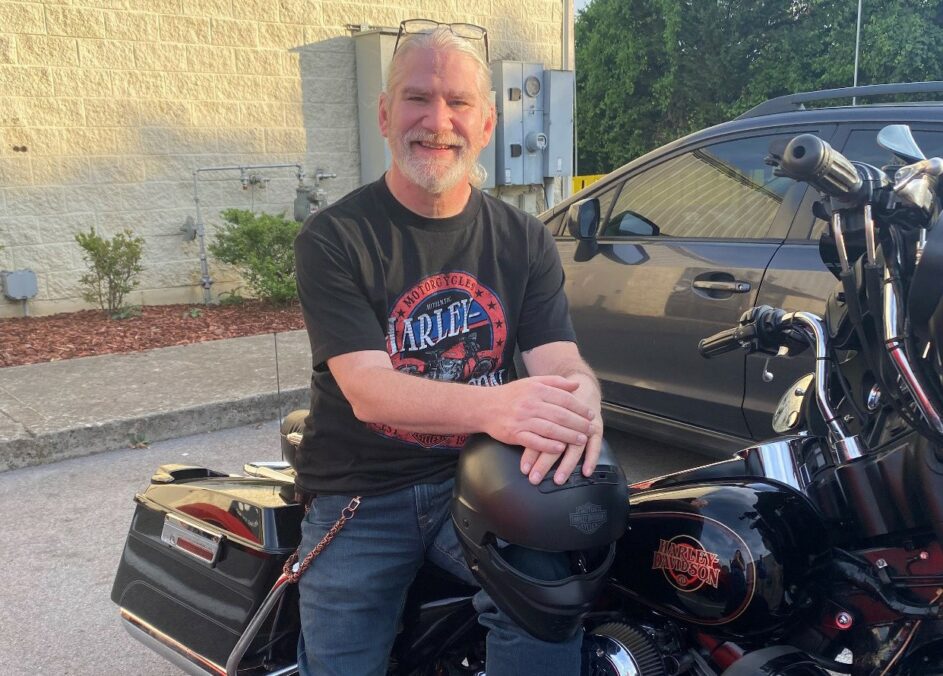Being a blacksmith is hard work, but one of its advantages is working with heat on bitterly cold days. The temperature was in the 20s on a wintry day last February. Michael Ensor stoked the fires of creativity and prepared to face the camera.
He wasn’t particularly nervous. The video demonstration Ensor was carrying out at The Great Smoky Mountains Heritage Center in Townsend would be easy for the experienced blacksmith. So why was he having symptoms of an anxiety attack?
“We watched the video and he kept dropping things,” Regina Ensor says as she and her husband sit side by side at Fort Sanders Cardiopulmonary Rehabilitation. “He never does that.”
The video project was halted when Michael confessed he was having trouble breathing. Back at home in Halls, Regina was still concerned about him. He didn’t feel well and his stomach was bloated.
After a couple of days, Regina took him to a clinic for a Covid test. She was told her husband needed to go to a hospital immediately because he might have a bowel obstruction. The surprising truth was revealed later at Fort Sanders Regional Medical Center. His symptoms weren’t the result of a bowel obstruction, Covid-19 or even an anxiety attack. Ensor was in congestive heart failure.
A Failing Heart
Heart disease can come with a wide array of symptoms that are easy to dismiss. When Ensor had trouble breathing, it was because his heart couldn’t pump out enough blood from his lungs, putting pressure on his heart and pushing fluid into his lungs’ air sacs.
The bloated stomach came from fluid that had reached his abdomen. Chest pain that felt like indigestion was the effect of reduced blood flow to his heart. Ensor underwent a five-bypass surgery requiring a special pump to help his left ventricle recover.
Unconscious in a medically induced coma, Ensor was placed on a ventilator, came off the ventilator, then was reintubated and had a tracheostomy. He also experienced pneumonia and infections.
After nearly two months, the turnaround came. Ensor’s condition began to improve. Jennifer Lamb and Chelsea Benson were among the many nurses who offered medical care and attentive compassion 24 hours a day, even washing his hair as he lay in the bed. “His spirit was just so great,” Lamb says. “He would see a familiar face and he would smile. He couldn’t say anything but you could tell he was happy.”
“You can’t keep him down,” Benson says. “He fought the whole way.”
Stronger Every Day
After being discharged from the hospital, Ensor was admitted to Patricia Neal Rehabilitation Center for a while and was then released to go home and begin a series of appointments for cardiopulmonary rehabilitation. Exercises strengthened his heart and built his endurance.
Rehabilitation not only helped heal Ensor’s physical heart, but also the heart of who he is. Laughter came more easily. Soon he began to enjoy life more, making friends with other patients.
“Everybody says ‘you’re so lucky,’ but no, I’m privileged,” Michael Ensor says. “I got my life back and had the people around me who made a difference.”
A return to blacksmithing isn’t an option yet because of the intense heat Ensor would be exposed to, but he’s back on his motorcycle and on the road. Little by little, life is getting back to normal. It’s something he doesn’t take for granted.
“It makes you thankful every day,” Ensor says. “To know where I was at, what I couldn’t do, and what I can do now – I’m very, very thankful.”
Ensor gives a lot of credit to his wife for her unfailing devotion, and believes he is thriving because he’s been well cared for from the moment he entered the emergency department, through surgery, critical care and into rehab. “If I was somewhere else I don’t think I would have made it, honestly,” Ensor says.
Know the signs of a heart attack
If you think you might be having a heart attack, call 911 if your symptoms don’t go away in five minutes or less. Minutes matter, and getting the help you need quickly could save your life.
The most common signs of a heart attack is discomfort in the center of the chest. It might feel like uncomfortable pressure, squeezing, fullness or pain and is sometimes mistaken for indigestion. Other signs to watch for include breaking out into a cold sweat, nausea, lightheadedness or dizziness, numbness of arms, unexplained discomfort in other areas of the upper body, and shortness of breath.
Cardiac Rehab
If you find yourself hospitalized with heart disease, your doctor will most likely recommend cardiac rehabilitation. Getting professional help in your recovery is important, and Fort Sanders Cardiopulmonary Rehabilitation is here to help you achieve a better quality of life after a cardiac event.
After evaluation, participants are given a program specifically tailored to their individual needs. Physical exercise can include treadmills, arm ergonometers, stationary bicycles, elliptical, machines, weights and steps. Each patient wears a heart monitor and is constantly being evaluated. The exercise program is updated as the patient progresses.
A cardiac rehab program can also include classes that cover topics like cooking heart-healthy foods and interpreting what’s on food labels at the grocery store. It’s a well-rounded approach to helping heart patients.
To learn more about cardiac rehabilitation and heart health, visit FSRegional.com/ CropProp or call 865-331-1250.
Information provided by the Public Relations Department of Covenant Health.

